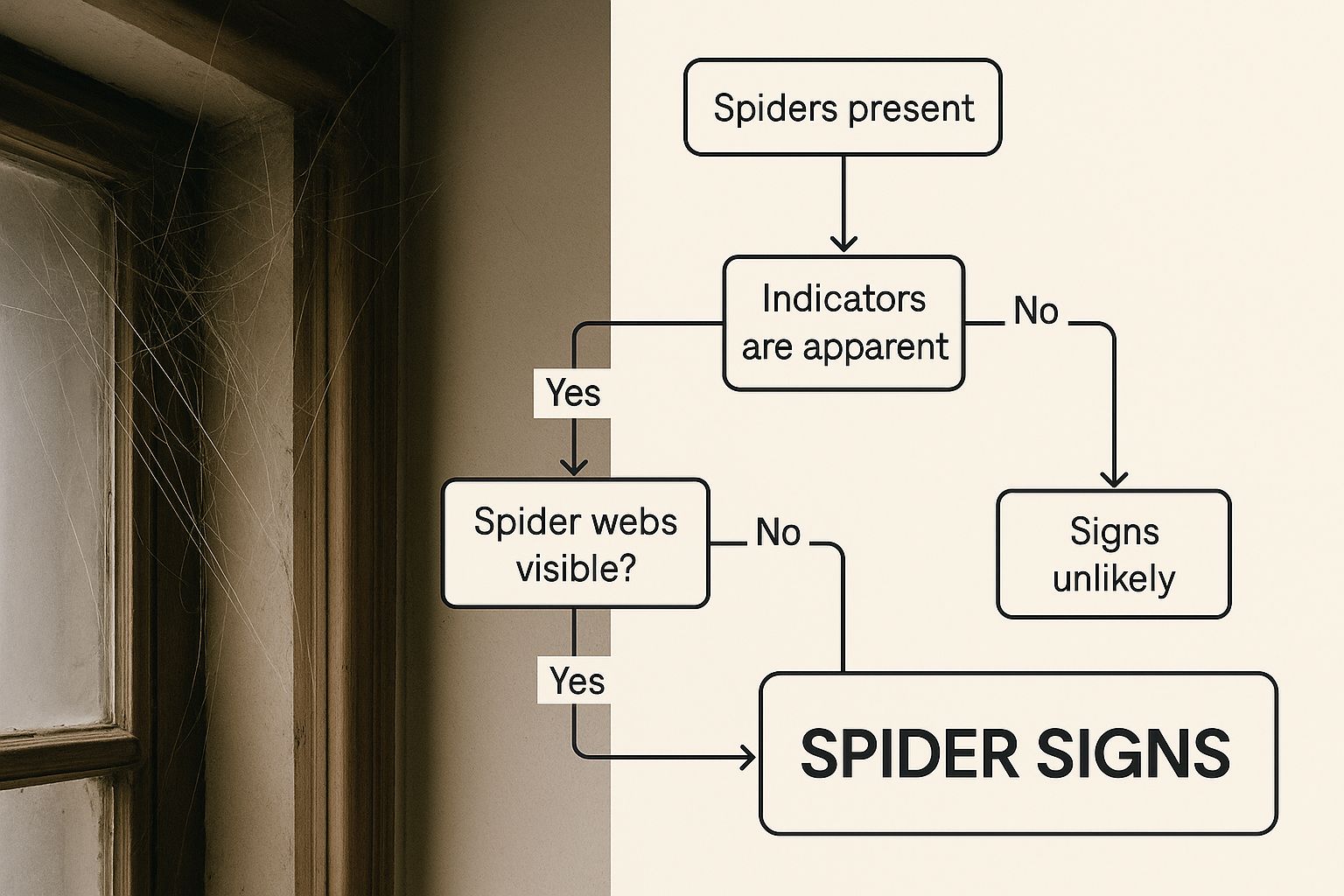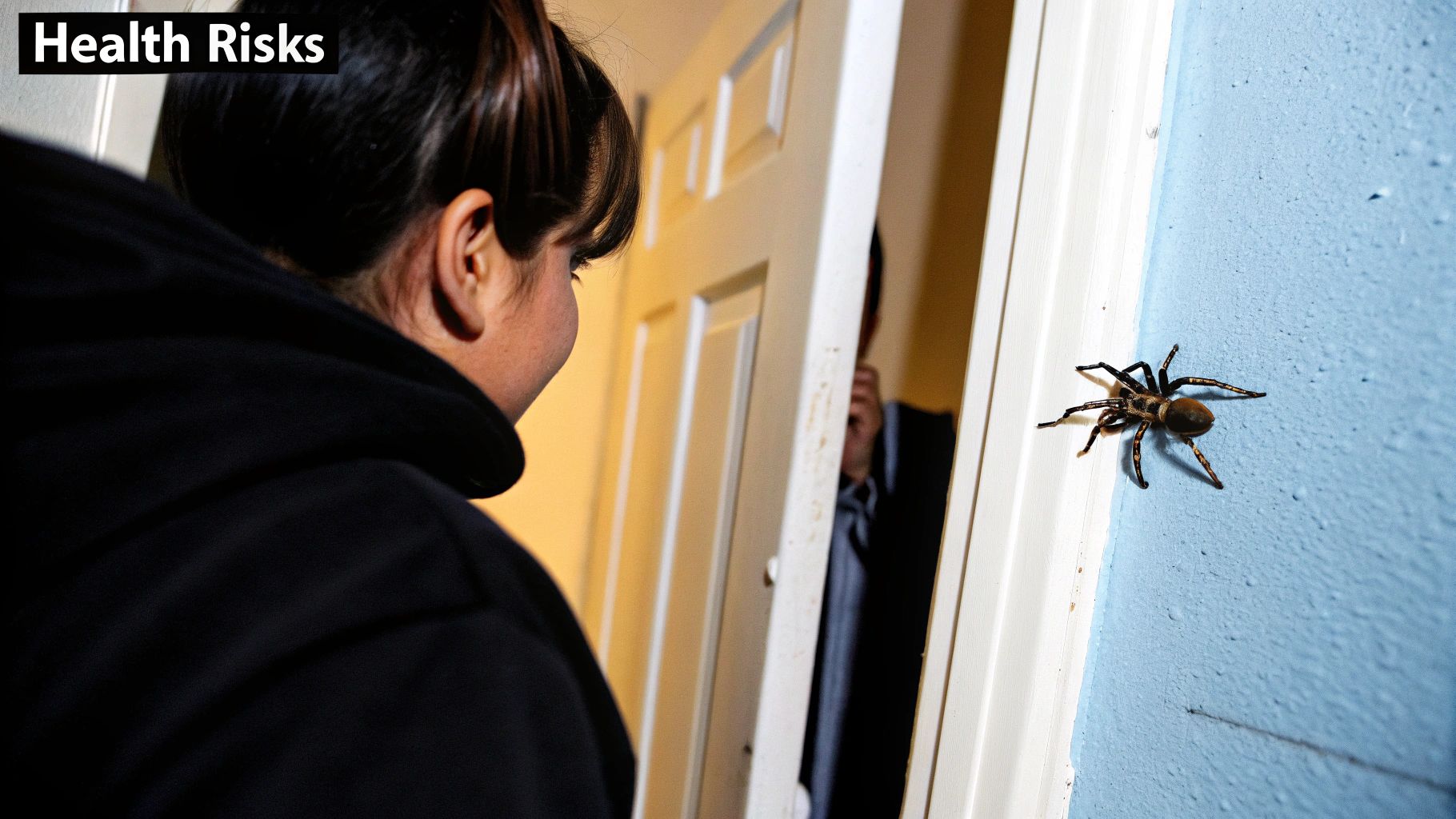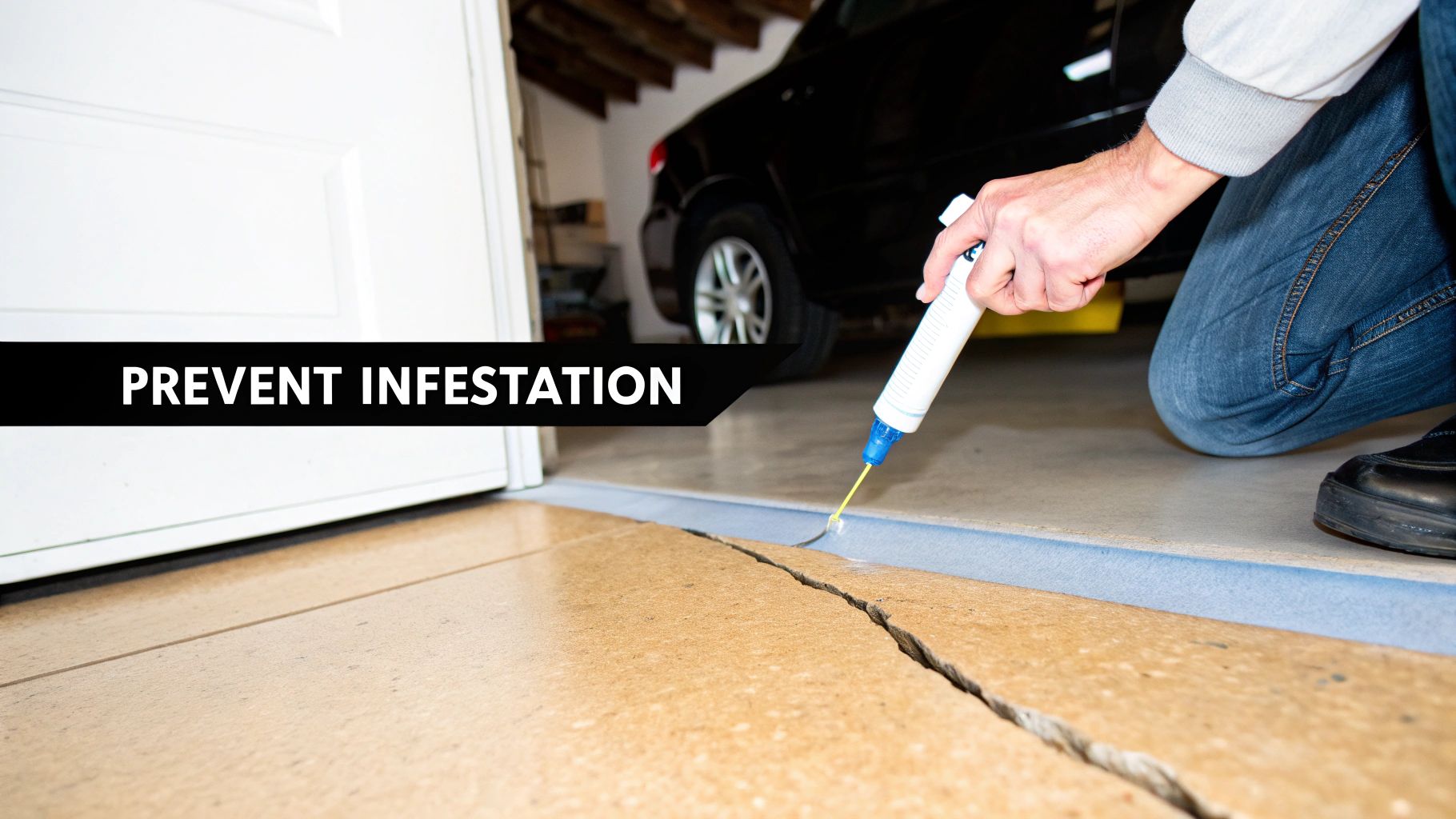We’ve all been there. You spot a spider scuttling across the floor or lurking in the corner of a room. It’s a common sight in most UK homes and usually nothing to worry about. But when does that one-off spider become a sign of something more?
A true infestation of spiders isn't just about seeing the odd arachnid. It’s a sign that a breeding population has decided to make your house its home. This is a completely different ball game, turning a minor nuisance into a growing problem that needs sorting.
Guest or Unwanted Tenant? Knowing the Difference
It’s natural to feel a bit on edge every time you see a spider, but it's important to know whether you're dealing with a lone visitor or a full-blown infestation. Think of it this way: a single spider is like a tourist who's taken a wrong turn. An infestation, however, is like that tourist inviting their entire extended family to move in permanently.
The trick is to stop panicking and start observing. Seeing one spider in the bath this week and another by the window next month is perfectly normal. These are just isolated incidents.
But a real infestation leaves clues. It’s not just about seeing more spiders; it’s about seeing the evidence that they’re settling in for the long haul. Here’s what to look out for:
- Frequent Sightings: Are you spotting spiders all the time and in different rooms? If they’re showing up regularly in the kitchen, bedrooms, and living areas, they’re not just passing through.
- A Web Takeover: A sudden and noticeable increase in webs around your home is a dead giveaway. It means active spiders are hunting, breeding, and claiming territory.
- Discovering Egg Sacs: This is the most definite sign of a breeding population. These small, silken, often ball-shaped sacs are usually tucked away in dark, quiet spots—under furniture, in corners, or behind clutter.
Quick Check: Occasional Spider vs Potential Infestation
Not sure where you stand? This quick table can help you figure out if you've got a few harmless visitors or a more serious spider problem brewing.
| Sighting or Sign | What It Means for an Occasional Spider | What It Means for a Potential Infestation |
|---|---|---|
| Sightings | One spider seen every few weeks. | Multiple spiders seen daily or weekly in various rooms. |
| Webs | A single, isolated web in a corner or window. | Numerous webs appearing quickly, often interconnected. |
| Egg Sacs | No egg sacs found. | Finding one or more silken egg sacs in hidden areas. |
| Other Pests | No noticeable increase in other insects. | An increase in flies, ants, or other small insects. |
If your situation leans more towards the "Potential Infestation" column, it's time to take a closer look at what's going on.
This handy visual guide can also help you connect the dots between what you're seeing and what it means.

As the guide shows, if you’re seeing lots of webs and finding egg sacs on top of frequent sightings, you're likely dealing with more than just a few lost spiders.
An infestation is often a symptom of a bigger issue. Spiders go where the food is. If your home can support a large spider population, it probably means you also have an underlying problem with the insects they prey on.
Ultimately, knowing these signs gives you the power to assess the situation properly. By recognising the patterns, you can figure out whether you need to take a more strategic approach to manage the infestation of spiders and get your peace of mind back.
Key Signs of a Spider Infestation in Your Home

Spotting a spider every now and then is perfectly normal. But how do you know when a few unwelcome visitors have turned into a full-blown infestation? It’s all about looking for the right clues. A true infestation of spiders isn't just about seeing more spiders; it's about the consistent evidence they leave behind. Think of yourself as a detective in your own home.
The most obvious sign, of course, is a sudden explosion of webs. If you go from dusting a single cobweb to finding new ones popping up almost overnight, that's a major red flag. It means multiple spiders are actively hunting and making themselves at home. These aren't just old, dusty relics; they're signs of a thriving population.
The Telltale Webs and Their Stories
Not all spider webs look the same, and the type of web you find can tell you a lot about the species you're sharing your space with. Each web is like a calling card, giving you clues about your uninvited guests.
Here are a few common web styles you'll likely see in UK homes:
- Orb Webs: These are the classic, wheel-shaped webs. They're usually made by garden spiders that have wandered indoors. Seeing one or two isn't a worry, but lots of them suggest there’s a good food source drawing them in.
- Tangled Webs: Messy, chaotic, and often tucked away in corners, cellars, and lofts. These are the handiwork of common house spiders.
- Funnel Webs: You'll spot these as a flat sheet of silk that narrows into a tube where the spider hides. They're typically built close to the ground, along skirting boards, or in cluttered spaces.
- Sheet Webs: These are like dense, silken blankets spun over shrubs outdoors, but they can also show up in sheds and garages.
By paying attention to the type of webs, not just how many there are, you get a much clearer picture of what you’re dealing with.
The presence of numerous, active webs is a definitive sign that spiders are finding everything they need to thrive in your home: shelter, safety, and most importantly, food. A house full of webs is a house full of spider prey.
The Crucial Discovery of Spider Egg Sacs
Finding a spider egg sac is probably the most concrete proof that you have a growing problem. This is the moment you know spiders aren’t just passing through—they’re breeding. These sacs are small, silken bundles, usually white or off-white, and can be round, teardrop-shaped, or stuck flat against a surface.
A single egg sac can hold hundreds of spiderlings. When they hatch, they’ll spread out and grow, causing the spider population in your home to explode.
Keep an eye out for them in these common hiding spots:
- Underneath chairs, tables, and in furniture joints.
- Tucked away in dark, quiet corners of rooms and cupboards.
- Stuck to the underside of shelves or window sills.
- Inside wall voids or deep within cluttered storage boxes.
If you find even one egg sac, it’s time to take action. It's a clear signal that spiders have decided your home is a safe place to raise a family.
An Unmistakable Increase in Other Pests
Here’s a sign that many people miss: a sudden increase in other pests. Spiders are predators. They only set up camp where there's a reliable food supply. If you're suddenly seeing more flies, ants, moths, or other little insects, you're essentially putting out a welcome mat for spiders.
Your home has become a well-stocked pantry for them. This secondary pest problem is the fuel that can turn a few stray spiders into a proper infestation. To get rid of the spiders, you first have to get rid of their food source.
Meet the Spiders Common in UK Homes

Before you can effectively tackle a spider problem, you need to know exactly who you’re sharing your home with. While the UK is home to over 650 different spider species, only a handful are likely to show up uninvited.
Getting to know these common houseguests isn’t about becoming an expert overnight. It’s about gathering a little bit of intelligence so you can make your home a less attractive place for them to settle down. Let’s meet the usual suspects.
The Giant House Spider (Eratigena species)
This is the one that sends people jumping onto chairs, especially in autumn. Famous for its long legs and surprising speed, the Giant House Spider looks intimidating but is mostly harmless. They spin funnel-shaped webs in sheds, garages, and quiet corners of the house that don't see much traffic.
You’re most likely to see the males during their late summer and autumn mating season. They leave their webs to go on a mission, searching for a female, which often results in that classic scene of a spider sprinting across your living room floor.
The Cellar Spider (Pholcus phalangioides)
Often called daddy-long-legs, these spiders are delicate, spindly creatures that love damp, dark places. You'll find them and their messy, tangled webs hanging out in cellars, basements, and behind bulky furniture.
They move slowly and are no threat at all. In fact, they can be quite helpful, as they're known to prey on other, more robust spiders—including the Giant House Spider.
The False Widow Spider (Steatoda nobilis)
No spider gets more bad press in the UK than the False Widow. You can spot them by their shiny, black, round abdomen, which often has cream-coloured markings. They spin a tangled, 3D web, usually in warmer spots like window frames, conservatories, and sheds.
It’s important to separate the media hype from reality. False Widows can bite if they feel trapped or threatened, but for most people, the effect is similar to a bee or wasp sting. Serious reactions are extremely rare.
Why Do Spiders Come Inside?
Spiders don't move into your home just to scare you. Their motivations are simple and boil down to basic survival. Figuring out their reasons is the first step toward keeping them out.
-
Looking for Food: The number one reason any spider sets up shop is a steady food supply. If your home has plenty of flies, ants, or other small insects, you’re basically running an all-you-can-eat buffet. This is why managing other pests is key; for example, learning what to do when you have ants in your home can make your property less inviting for spiders.
-
Searching for a Mate: As we saw with the Giant House Spider, autumn is prime time for spider sightings. This is when males are on the move, looking for females, and your warm, dry house makes for a perfect meeting spot.
-
Seeking Shelter: When the weather turns cold and wet, your home offers a warm, stable refuge. Spiders will find their way in through tiny cracks, gaps around windows and doors, and open vents.
By understanding these common spiders and why they’re in your home, you can shift from reacting to every sighting to proactively making your space less welcoming for these eight-legged visitors.
How to Make Your Home Less Inviting to Spiders
When it comes to spiders, the best defence is a good offence. The most effective way to handle an infestation of spiders is to stop one from ever getting started. By making your home a less attractive place for them, you can prevent these eight-legged visitors from getting a foothold in the first place.
Think of it as putting up a "no vacancy" sign. This proactive approach is all about creating a fortress, sealing up entry points, and managing the environment inside and outside your home to take away what spiders need: food, shelter, and easy access. You don’t need any specialist skills, just a keen eye and a bit of effort.
Sealing Every Crack and Crevice
Spiders are absolute masters of infiltration. They can squeeze through the tiniest openings you’d never even notice. Your first job is to do a thorough walk-around of your home's exterior and seal up these potential gateways.
Start with your foundation. Look for any cracks, no matter how small, as these are open invitations for pests. Use a good quality caulk or sealant to fill them in, paying extra attention to where utility pipes, vents, and wires enter your house.
Next, turn your attention to the windows and doors. Worn-out weatherstripping and poorly sealed frames are basically motorways for spiders and the insects they hunt. Repair or replace any damaged seals and check that every window and door closes snugly, leaving no gaps.
Controlling the Environment Inside and Out
Once you’ve battened down the hatches, it’s time to make the inside of your home less welcoming. Spiders love clutter. It gives them endless dark, undisturbed places to hide out, spin webs, and lay their eggs.
A clean, organised home is one of your most powerful weapons against a spider infestation. When you take away their hiding spots, you take away the security they need to settle in and breed.
Get ruthless with the decluttering, especially in these prime spider hotspots:
- Attics and Lofts: Often used for long-term storage, these areas can quickly become cluttered havens for spiders. Switch from cardboard boxes (which get damp and attract pests) to sealed plastic containers.
- Basements and Cellars: Just like attics, these spaces are perfect spider territory. Keep everything off the floor and away from the walls to make it harder for them to hide.
- Cupboards and Wardrobes: Give these a regular clear-out, particularly the ones at the back you rarely open.
Managing Your Garden and Outdoor Lighting
Your garden can easily become a staging ground for a home invasion. If spiders find perfect conditions right outside your property, it’s only a matter of time before they start exploring indoors. Keep things tidy by trimming back bushes, trees, or climbing plants that touch your walls or roof. This creates a clear buffer zone that spiders are much less likely to cross.
Outdoor lighting is another huge factor. Your standard white lightbulbs are incredibly attractive to flying insects like moths and flies—a spider’s favourite meal. By drawing their food source right up to your doors and windows, you’re basically setting up an all-you-can-eat buffet.
Try this simple but effective change:
- Switch to yellow or sodium vapour bulbs. Insects struggle to see light in the yellow spectrum. Making this one switch can dramatically cut down on the number of bugs swarming your lights, which in turn makes the area far less interesting to hunting spiders.
By taking these straightforward steps, you can systematically roll up the welcome mat. It’s a simple combination of physical barriers and smart environmental changes that puts you back in control. A sealed, clean, and well-maintained property is fundamentally less likely to suffer from a persistent infestation of spiders, giving you real peace of mind.
Safe and Effective DIY Spider Removal Methods
So, you’ve spotted more than just the occasional eight-legged visitor and you're pretty sure a spider problem is brewing. Before you reach for harsh chemicals, there are several simple, effective DIY methods you can use to get things under control, especially if the infestation of spiders is in its early stages.
These tactics focus on physically removing the spiders and making your home a less inviting place for them to set up camp.
Your vacuum cleaner is your best friend here. It's a fantastic tool for getting rid of spiders, their webs, and importantly, any egg sacs tucked away in corners. Pop on an extension wand to easily reach high ceilings, the gaps behind furniture, and along skirting boards where they love to lurk. It’s quick, clean, and deals with the problem head-on.
Crucial Tip: After you’ve finished vacuuming, don’t just put the cleaner away. Make sure you take the bag or canister outside and empty it straight into your outdoor bin. This stops any survivors or newly hatched spiderlings from simply crawling back out and starting all over again.
Using Natural Deterrents Correctly
You've probably heard about using natural deterrents, but it's important to know what they can and can't do. Spiders "taste" and "smell" through their legs, and they absolutely detest strong scents like peppermint oil, tea tree oil, and citrus.
However, these are not a magic cure for an existing infestation. Think of them as a "keep out" sign, not an eviction notice. They’re great for discouraging new spiders from coming in, but they won't force out the ones already living and breeding inside your home.
Here’s how to use them effectively:
- Mix a few drops of your chosen essential oil with water in a spray bottle.
- Lightly spritz the mixture around entry points like window frames, door sills, and air vents.
- Reapply it every few days. The scent fades over time, so you’ll need to top it up to keep it working.
While natural scents are a nice addition to your pest control efforts, they shouldn't be your only line of defence against a growing spider problem. Their real strength is in prevention.
The Strategic Use of Sticky Traps
Sticky traps are another excellent, non-toxic tool. They're perfect for both monitoring the situation and reducing the number of spiders scuttling around. By placing these glue boards in spots where you suspect activity, you can get a much better idea of how big your problem really is.
For the best results, place them in quiet, hidden locations:
- Underneath sofas and beds.
- Behind kitchen appliances or in the utility room.
- Inside cupboards, attics, and cellars.
- Along the walls in your garage or shed.
Checking the traps every so often will show you where the spider hotspots are and tell you if your other removal methods are making a difference. While they won't solve a major infestation of spiders by themselves, they are a vital part of a smart, combined approach.
Just like knowing when it's time to call in the pros for wasps or bees, understanding the limits of DIY is crucial. For more complex pest issues, you might find our guide on what to do about wasps and bees helpful. By combining these simple, safe methods, you can make a real dent in your home's spider population and get your peace of mind back.
Right, you've tried the hoover, you've sealed the cracks, but the eight-legged lodgers just keep coming back. While dealing with the odd spider is one thing, knowing when to throw in the towel and call for backup is key. Deciding to get professional help isn't admitting defeat; it’s the smartest move you can make to reclaim your home quickly and safely.
Sometimes, despite your best efforts, the problem just won't go away. If you've cleaned and sealed everything in sight but are still finding spiders, it’s a sign that the infestation is more established than you can handle. A professional can get to the root of the issue, not just chase the ones you can see.
Key Triggers for Calling an Expert
Don't wait until you're completely overrun. If you spot any of these red flags, it’s time to pick up the phone. Acting fast is crucial.
- Numerous Egg Sacs: Finding one of these little silk bundles is a warning. Finding several is a sign that a population explosion is just around the corner. Each one can hold hundreds of spiderlings.
- A Potentially Venomous Species: If you think you’ve got False Widows, especially in places where your family relaxes like the living room or bedrooms, don’t take chances. An expert can identify them correctly and deal with them safely.
- Overwhelmed by Numbers: Are you seeing multiple spiders every single day? At that point, the population is well-established, and DIY methods are like trying to empty the ocean with a teacup.
A professional assessment gives you more than just a quick spray. It’s a complete strategy. Experts understand spider behaviour, their life cycles, and exactly what’s attracting them to your home in the first place. This leads to a solution that actually lasts.
Deciding to call for help is more common than you might think. When faced with a pest problem, swift action is widely recognised as the best approach. In fact, one report found that nearly 35% of residents contacted professionals within a single day of discovering an infestation. You can see more details in this report on UK pest trends.
A professional pest controller has access to treatments that are far more effective and targeted than anything available over the counter. They can tackle the entire life cycle—from egg to adult—to break the chain for good. If you're tired of fighting a losing battle, looking into professional pest control services is the surest way to get your peace of mind back.
Common Questions About Spider Infestations
Even with the best intentions, it's easy to have questions when you think you might have a pest problem. Finding spiders can be unsettling, so getting clear, direct answers is key.
This quick guide tackles the most common queries we hear from homeowners. Think of it as your final checklist for understanding what's happening and how to handle it with confidence.
Does One Spider Egg Sac Mean I Have an Infestation?
Finding a single spider egg sac isn't a full-blown infestation, but it’s a massive warning sign you can't afford to ignore. Think of it as the first spark before a fire—it has the potential to become a much bigger problem, fast.
A single sac can release hundreds of tiny spiderlings into your home. If you find one, get rid of it immediately. Vacuuming it up is a great way to do this. Afterwards, you need to do a thorough search for more in all the usual hiding spots: dark corners, under furniture, and deep inside cupboards.
If you discover multiple egg sacs, that’s a clear signal that a breeding population is getting comfortable. The problem has just shifted from a potential threat to an active infestation, and that calls for a much stronger response.
Are Natural Repellents Like Peppermint Oil Actually Effective?
Natural repellents can help discourage spiders, but they won't cure an existing infestation. Spiders "taste" and "smell" the world through their legs, and they genuinely dislike strong scents like peppermint, tea tree, or citrus oils.
This means they might avoid crossing a windowsill or doorway you've treated. However, the effect is temporary and you'll need to reapply it often. More importantly, these oils do nothing to spiders already living and breeding inside your home, and they certainly won't affect their egg sacs.
Use them as part of a prevention strategy, but don’t rely on them to solve a confirmed problem.
Will Controlling Other Insects Reduce My Spider Problem?
Yes, absolutely. This is one of the most powerful, long-term strategies for keeping spiders out. Spiders are predators; they only set up shop where there's a reliable food source.
If your home has a steady supply of flies, ants, moths, or other small insects, it’s basically an all-you-can-eat buffet for spiders. By managing these other pests through good sanitation, sealed food containers, and targeted control, you make your home far less appealing.
Cutting off their food supply is an incredibly effective way to encourage spiders to move on and stop new ones from moving in.
Feeling overwhelmed by a spider problem that won't go away? Don't let it become a constant source of stress. The experts at Pest Predators Limited offer science-backed, long-term solutions to reclaim your peace of mind. Contact us today to discuss a tailored treatment plan for your home.
Article created using Outrank



